
Rodgers and Hammerstein may have had their first (and longest-running) Broadway smash with Oklahoma! The Sound Of Music may well be their best-loved hit, thanks in large measure to the big-screen Julie Andrews movie classic. South Pacific and The King And I may each have their passionate fans, among which this reviewer counts himself. Be that as it may, in my humble opinion, none of the above quite match the overall brilliance and innovation of the extraordinary Carousel, R&H’s second Broadway hit.
It is this 1945 Rodgers and Hammerstein classic that the enormously talented students o“Ballet.” Cal State Fullerton’s illustrious Musical Theatre BFA program now bring back to powerful, gorgeous life for 21st Century audiences.
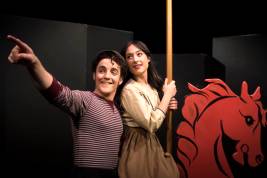 If all you knew about Rodgers and Hammerstein was The Sound Of Music, you might expect an R&H show called Carousel with its big production numbers like “June Is Bustin’ Out All Over” to be all “raindrops on roses and whiskers on kittens,” especially considering its mid ‘40s Broadway debut, over a decade before shows started getting dark and dramatic with Bernstein and Sondheim’s West Side Story.
If all you knew about Rodgers and Hammerstein was The Sound Of Music, you might expect an R&H show called Carousel with its big production numbers like “June Is Bustin’ Out All Over” to be all “raindrops on roses and whiskers on kittens,” especially considering its mid ‘40s Broadway debut, over a decade before shows started getting dark and dramatic with Bernstein and Sondheim’s West Side Story.
Think again. Despite its cotton candy façade, Carousel has at its heart a love story between a woman who marries “below her class” and a husband who, when confronted with his own inadequacies, lashes out in the only way he knows—with a slap. Hardly the stuff of “bright copper kettles and warm woolen mittens.”
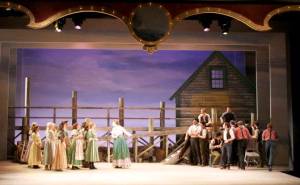 Based on Hungarian playwright Ferenc Molnár’s 1909 play Liliom, Carousel transports us to a seaside Maine town circa 1873, where young girls toil daily in the local mill before escaping each night to stand in line for their turn on the town’s merry-go-round, if only to be near the carousel’s darkly sexy barker Billy Bigelow. Though there’s hardly a girl in town not smitten with Billy, it’s clear from the start that the carousel barker only has eyes for the beautiful Julie Jordan and she for him, so much so that within hours of their first conversation, both Billy and Julie will have fallen in love—and lost their jobs as a consequence.
Based on Hungarian playwright Ferenc Molnár’s 1909 play Liliom, Carousel transports us to a seaside Maine town circa 1873, where young girls toil daily in the local mill before escaping each night to stand in line for their turn on the town’s merry-go-round, if only to be near the carousel’s darkly sexy barker Billy Bigelow. Though there’s hardly a girl in town not smitten with Billy, it’s clear from the start that the carousel barker only has eyes for the beautiful Julie Jordan and she for him, so much so that within hours of their first conversation, both Billy and Julie will have fallen in love—and lost their jobs as a consequence.
The couple soon marry, but all is hardly sunshine, lollipops, and rainbows. Two months later Billy is still jobless, and has hit Julie, only once so far, but that’s enough for friends to advise the young bride to cut her losses and get out of an abusive marriage, something she steadfastly refuses to do. When Billy learns that Julie is pregnant, he makes a decision that will alter their lives forever.
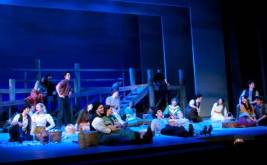 The 1956 film (which starred the perfectly cast duo of Gordon MacRae and Shirley Jones, fresh from Oklahoma! movie stardom) gave away an Act Two plot twist in its opening sequence, a mistake this reviewer will not repeat, in hopes that at least some in the CSUF audience will get to feel Carousel’s full impact without detriment of spoilers.
The 1956 film (which starred the perfectly cast duo of Gordon MacRae and Shirley Jones, fresh from Oklahoma! movie stardom) gave away an Act Two plot twist in its opening sequence, a mistake this reviewer will not repeat, in hopes that at least some in the CSUF audience will get to feel Carousel’s full impact without detriment of spoilers.
Better now to focus on Carousel’s ground-breaking highlights, like daring to open a musical without an overture, instead starting the show with an extended eight-minute “Prologue” during which the orchestral “Carousel Waltz” underscores a dialog-free introduction to the musical’s carnival setting, its main characters, and assorted townspeople.
Equally revolutionary is the extended music-and-dialog sequence of Act One’s famous “bench scene.”
 Over the course of twelve magical minutes, Billy and Julie go from virtual strangers to couple-in-love in a series of ever-changing rhythms and melodies reflecting emotions in transition. There’s Julie’s jaunty declaration that “if I did have money, you couldn’t take any, cause you’d ask and I’d give it to you,” to which Billy replies in wonder (reprising “You’re A Queer One, Julie Jordan”), “Ain’t you ever had a feller at all?” Then comes some musically-underscored spoken dialog, common in films but a Broadway musical ground-breaker, before Julie vows, “I’m never gonna marry. If I was gonna marry, I wouldn’t have to be such a stickler. But I’m never gonna marry, and a girl who don’t marry has got to be much more partic’lar.” After that comes more underscored dialog and a bit more of “You’re A Queer One” before the orchestra at last launches into the first strains of the now classic love duet “If I Loved You,” like Oklahoma!’s “People Will Say We’re In Love,” Rodgers And Hammerstein’s way of getting around a couple’s inability to profess their love outright.
Over the course of twelve magical minutes, Billy and Julie go from virtual strangers to couple-in-love in a series of ever-changing rhythms and melodies reflecting emotions in transition. There’s Julie’s jaunty declaration that “if I did have money, you couldn’t take any, cause you’d ask and I’d give it to you,” to which Billy replies in wonder (reprising “You’re A Queer One, Julie Jordan”), “Ain’t you ever had a feller at all?” Then comes some musically-underscored spoken dialog, common in films but a Broadway musical ground-breaker, before Julie vows, “I’m never gonna marry. If I was gonna marry, I wouldn’t have to be such a stickler. But I’m never gonna marry, and a girl who don’t marry has got to be much more partic’lar.” After that comes more underscored dialog and a bit more of “You’re A Queer One” before the orchestra at last launches into the first strains of the now classic love duet “If I Loved You,” like Oklahoma!’s “People Will Say We’re In Love,” Rodgers And Hammerstein’s way of getting around a couple’s inability to profess their love outright.
There’s also the thematically and musically complex “Soliloquy,” seven extraordinary minutes during which Billy Bigelow, alone on stage, goes from wondering in song what his as-yet unborn son will think of a father like him, to joyously imagining all the things he and his “boy Bill” will do together, to the sudden frightening realization that his future son might actually be a daughter, to a vow to do whatever it takes to prevent his little girl from being “dragged up in slums with a lot o’ bums” like her father: “I never knew how to get money,” Billy belts to the heavens, “but, I’ll try, by God I’ll try! I’ll go out and make it or steal it or take it or die!”
Then there’s the justly famed Act Two “Ballet,” Carousel’s follow-up to Oklahoma!’s dream ballet, in which we see through the medium of dance what it feels like to be the teenage child of a father with the reputation of being a bum … and worse.
End of Musical Theater History lecture.
As for what makes Cal State Fullerton’s Carousel so successful, let’s start with the inspired work of director Eve Himmelheber and choreographer William F. Lett, CSUF faculty members in charge of the school’s highly selective BFA in Musical Theater program.
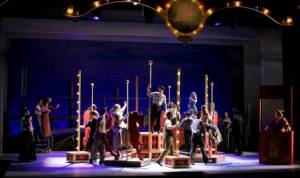 Taking as their inspiration Nicholas Hytner’s brilliant 1994 Broadway revival, Himmelheber and Lett open the production with a line of young female millworkers stretching across an upstage bridge and miming the monotony of working at a loom from dawn to dusk before heading off to an evening at the fair. Cast members then bring on the elements of a carousel, creating a merry-go-round right before our eyes, one which they spin round and round as among the carousel’s many female riders, the carnival barker’s obvious interest in Julie Jordan provokes an angry, jealous response from his Billy-hungry boss Mrs. Mullin.
Taking as their inspiration Nicholas Hytner’s brilliant 1994 Broadway revival, Himmelheber and Lett open the production with a line of young female millworkers stretching across an upstage bridge and miming the monotony of working at a loom from dawn to dusk before heading off to an evening at the fair. Cast members then bring on the elements of a carousel, creating a merry-go-round right before our eyes, one which they spin round and round as among the carousel’s many female riders, the carnival barker’s obvious interest in Julie Jordan provokes an angry, jealous response from his Billy-hungry boss Mrs. Mullin.
And then we’re into the story, and a trio of stellar performances that play a large part in making this Carousel the best I’ve seen since the Hytner revival played the Ahmanson in 1996.
 Keaton Williams and Gina Velez move from their star turns as Tony and Maria in the Chance Theater’s Production Of The Year Scenie-winning West Side Story to the equally iconic Billy and Julie, roles which allow this match-made-in-heaven duo to surpass their already memorable previous collaboration.
Keaton Williams and Gina Velez move from their star turns as Tony and Maria in the Chance Theater’s Production Of The Year Scenie-winning West Side Story to the equally iconic Billy and Julie, roles which allow this match-made-in-heaven duo to surpass their already memorable previous collaboration.
Compact but sturdily built Williams not only looks the part of Billy, he reveals considerable acting chops in the role, which along with his gorgeous baritone make “Soliloquy” every bit the showstopper it is meant to be. Keep your eye on Williams, a young musical theater performer who is definitely going places.
As for his leading lady, it’s impossible to watch the enchanting Velez and not be reminded of a young Shirley Jones, albeit with long dark locks, the CSUF senior giving an exquisitely nuanced performance as a young woman who sees so deeply beneath Billy’s tough guy bravado that she can understand and even pardon the domestic violence that is a symptom of his frustration at not living up to her love and expectations. And wait till you hear Velez sing those classic Rodgers and Hammerstein songs in a soprano that must be a gift from the angels.
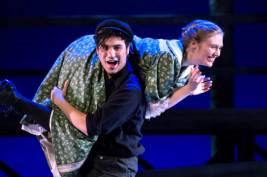 Audrey Curd completes the stellar trio with an absolutely delightful performance as Julie’s best friend Carrie Pipperidge, whose marriage to Mr. Snow turns out to be a good deal less tumultuous than Julie’s (i.e. a good deal more boring). From the perky “You’re A Queer One, Julie Jordan” to the wistful “When I Marry Mr. Snow” to the charming “When The Children Are Asleep,” Curd provides much more than the mere comic relief a lesser Carrie might bring to the role.
Audrey Curd completes the stellar trio with an absolutely delightful performance as Julie’s best friend Carrie Pipperidge, whose marriage to Mr. Snow turns out to be a good deal less tumultuous than Julie’s (i.e. a good deal more boring). From the perky “You’re A Queer One, Julie Jordan” to the wistful “When I Marry Mr. Snow” to the charming “When The Children Are Asleep,” Curd provides much more than the mere comic relief a lesser Carrie might bring to the role.
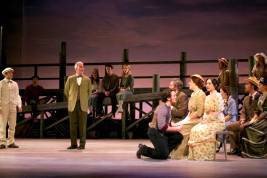 Supporting performances reveal musical theater performers of considerable promise, from Timothy Fitzsimon’s ever so proper Mr. Snow to William Hoshida’s sexily dangerous Jigger Crain to Amy Trgovac’s warm and wise Nettie Fowler. The casting of over-30 Craig Tyrl as the Star Keeper and Doctor Seldon proves an inspired choice, the MFA student bringing gravitas to roles often reserved for an actor in his seventies. Melissa Haygood (Mrs. Mullin), Mitchell McCollum (Mr. Bascombe), and Edgar Lopez (1st Heavenly Friend) deliver finely-tuned supporting turns. Victoria Rosser has a nice cameo as the school principal and Mallory Staley as 2nd Heavenly Friend.
Supporting performances reveal musical theater performers of considerable promise, from Timothy Fitzsimon’s ever so proper Mr. Snow to William Hoshida’s sexily dangerous Jigger Crain to Amy Trgovac’s warm and wise Nettie Fowler. The casting of over-30 Craig Tyrl as the Star Keeper and Doctor Seldon proves an inspired choice, the MFA student bringing gravitas to roles often reserved for an actor in his seventies. Melissa Haygood (Mrs. Mullin), Mitchell McCollum (Mr. Bascombe), and Edgar Lopez (1st Heavenly Friend) deliver finely-tuned supporting turns. Victoria Rosser has a nice cameo as the school principal and Mallory Staley as 2nd Heavenly Friend.
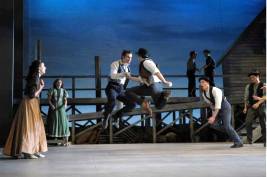 As for the dance ensemble, they are as athletically graceful a bunch as you’ll see on any SoCal stage, executing Lett’s moves—the very best choreography I’ve seen yet from the very talented CSUF faculty member—to breathtaking perfection in “June Is Bustin’ Out All Over” and the Act Two “Ballet.” They are Erica Beck, Kacy Cross, Michael Dashefsky, Katie Ellis, Nick Gardner, Emily Goedken, Devon Hadsell, Stephanie Inglese, Bren Thor Johnson, Tyler Lemire, Kirk Schuyler Lawson, Dominic Leslie, Lopez, Kellianne Safarik, Andrew Sattler, Staley, Chad Takeda, and Brian Whitehill—with special kudos to Hadsell for her charming, graceful performance as Louise.
As for the dance ensemble, they are as athletically graceful a bunch as you’ll see on any SoCal stage, executing Lett’s moves—the very best choreography I’ve seen yet from the very talented CSUF faculty member—to breathtaking perfection in “June Is Bustin’ Out All Over” and the Act Two “Ballet.” They are Erica Beck, Kacy Cross, Michael Dashefsky, Katie Ellis, Nick Gardner, Emily Goedken, Devon Hadsell, Stephanie Inglese, Bren Thor Johnson, Tyler Lemire, Kirk Schuyler Lawson, Dominic Leslie, Lopez, Kellianne Safarik, Andrew Sattler, Staley, Chad Takeda, and Brian Whitehill—with special kudos to Hadsell for her charming, graceful performance as Louise.
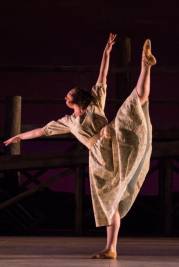 CSUF faculty member Mitchell Hanlon deserves high marks for his musical direction, doing double duty conducting a capable but not-quite-yet-at-professional-level student orchestra.
CSUF faculty member Mitchell Hanlon deserves high marks for his musical direction, doing double duty conducting a capable but not-quite-yet-at-professional-level student orchestra.
Carousel sports a tiptop design package, thanks to student designers Amy Shuffield (set), Jessy Henning (lighting), Joey Welden (sound), and Laura Young (hair and makeup) and guest artist Rachael Lorenzetti (costumes). Shuffield’s gorgeous scenic design is particularly impressive, her non-literal choices a just-right fit for Hemmelheber’s directorial concept. Debra Garcia Lockwood is production stage manager.
A faculty-supervised team of student designers and assistants make for a list of names too numerous to mention here, but all deserve an ovation for their work.
CSUF’s Carousel proves a worthy successor to the Department of Theatre & Dance’s previously reviewed big-stage productions of Rent, Footloose: The Musical, The Wedding Singer, and Little Women The Musical. With ticket prices a mere fraction of what you’d pay for a professional production at MTW or 3-D Theatricals and an all-around terrific cast of Broadway-bound musical theatre majors onstage, Carousel is must-see entertainment for anyone in the mood for a Broadway classic done right.
Little Theatre, California State University, Fullerton Department of Theatre & Dance, 800 N. State College Blvd., Fullerton.
www.fullerton.edu/arts/theatredance
–Steven Stanley
December 8, 2012
Photos: Francis Gerard Gacad, Edwin Lockwood


 Since 2007, Steven Stanley's StageSceneLA.com has spotlighted the best in Southern California theater via reviews, interviews, and its annual StageSceneLA Scenies.
Since 2007, Steven Stanley's StageSceneLA.com has spotlighted the best in Southern California theater via reviews, interviews, and its annual StageSceneLA Scenies.







 COPYRIGHT 2024 STEVEN STANLEY :: DESIGN BY
COPYRIGHT 2024 STEVEN STANLEY :: DESIGN BY